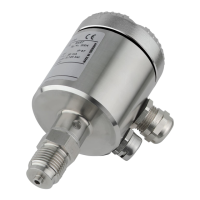10 IM/261Gx/Ax-EN Rev. 08 | 261Gx, 261Ax
3 Function and system design
Digital pressure transmitters are communication-ready field
devices with microprocessor-controlled electronics.
For bidirectional communication, an FSK signal is
superimposed on the 4 to 20 mA output signal in accordance
with the HART protocol.
The graphic user interface (DTM) can be used to configure,
poll, and test the pressure transmitter on a PC. Handheld
terminals also support communication.
For ‘local’ operation, a button is available on the device
electronics to set initial value and final value. In combination
with an optionally installed LCD indicator, a complete external
configuration and parameter setting of the transmitter can be
performed via the four local pushbutton controls.
The sturdy electronics housing is made of stainless steel and
is resistant to aggressive atmospheres. The process
connection is also made of stainless steel or Hastelloy C.
The name plate contains information about the specific
pressure transmitter design (see ‘Safety / Name plates’
chapter).
IMPORTANT (NOTICE)
For explosion-proof designs, the Ex design, or in
case of attached diaphragm seals, the
corresponding diaphragm seal type, is specified
on a separate plate.
In addition, a tag indicating the measuring points may be
attached (as an option).
3.1 Operation and system setup
The transmitter has a compact design and comprises the
pressure measuring cell and electronic unit with pushbutton
control. Depending on the measuring range and measured
variable, a silicon pressure sensor is used.
Silicon pressure sensor
In case of silicon pressure sensors, the pressure is transferred
via the separation diaphragm and the filling fluid to the
measuring diaphragm. The resistance values of the four piezo
resistors doped in the measuring diaphragm will change.
This pressure-proportional, internal output voltage is
converted via the electronic unit into a scaled electrical signal.
Depending on the model, the transmitter is connected to the
process by means of a spigot G ½ B (DIN EN 837-1), ½-
14 NPT male or female thread, flush diaphragm with special
thread G ½" for, e.g., ball valve connection or different
pressure sensors.
The pressure transmitter operates on the basis of two-wire
technology. The same lines are used for the operating voltage
(device-specific, see ‘Specification’ chapter) and the
standardized output signal. The electrical connection is
established via a cable entry or plug.

